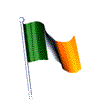

 |
If you lived in Ireland or Eire as it is sometimes known, you'd be living on an island which has been inhabited by people since the Stone Age. Approximately 3.8 million people live in Ireland. The number of people living in Ireland is about half the number of people who live in New York City. Ireland is very green and is known as the Emerald Isle. The reason for the green is that there is a relative lack of trees as much of the soil is bog-like and unsuitable for forestation. Grass, however, is still able to grow and covers the landscape giving Ireland a blanket of green. |
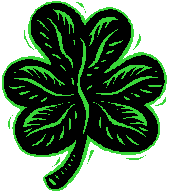
|
|
The weather in Ireland is temperate and wet. One had better enjoy the rain if they are planning on visiting or living in Ireland. The temperatures range from between 4° Celsius to 16° Celsius. Celsius is the standard unit of temperatures in Ireland. To find out the degrees in Fahrenheit, multiply the Celsius degrees by 1.8 and add 32. People in Ireland speak English, although Gaelic is Ireland's first national language and English is the second national language. More and more people are speaking Gaelic now and it may be an interesting language to learn! |
Food in Ireland consists of a lot of meat and potatoes, You won't have to go far to find stewed tomatoes and spuds. And the Irish drink a lot of milk. They drink more milk that any other European Country.
| The capital of Ireland is Dublin. The government of Ireland consists of a prime minister, a president and two branches of parliament, And in Ireland the national day is March 17th -- Saint Patrick's Day, If you lived in Ireland this would be one of the best days of the year! | 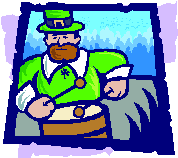 |
The Irish flag has three equal vertical bands of green (hoist side), white, and orange; similar to the flag of Cote d'Ivoire, which is shorter and has the colours reversed - orange (hoist side), white, and green; also similar to the flag of Italy, which is shorter and has colours of green (hoist side), white, and red.

![]()
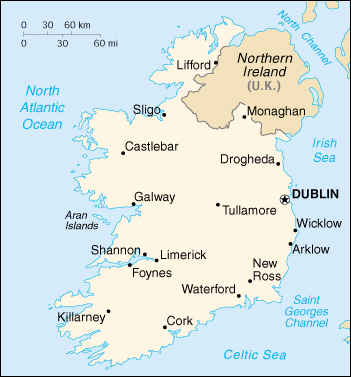
|
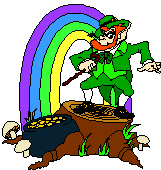 |
| Ethnic Groups: Celtic, English. | |
| Money: Irish pound. | |
| Natural resources: zinc, lead, natural gas, barite, copper, gypsum, limestone, dolomite, peat, silver. | |
| Agriculture and products: turnips, barley, potatoes, sugar beets, wheat; beef, dairy products. | |
| Exports: machinery and equipment, computers, chemicals, pharmaceuticals; live animals, animal products. | |
| Imports: data processing equipment, other machinery and equipment, chemicals; petroleum and petroleum products, textiles, clothing. | |
| Terrain: mostly level to rolling interior plain surrounded by rugged hills and low mountains; sea cliffs on west coast. | |
| Climate: temperate maritime; modified by North Atlantic Current; mild winters, cool summers; consistently humid; overcast about half the time. | |
| Elevation extremes: lowest
point: Atlantic Ocean 0 m, highest point: Carrauntoohil 1,041 m. |
